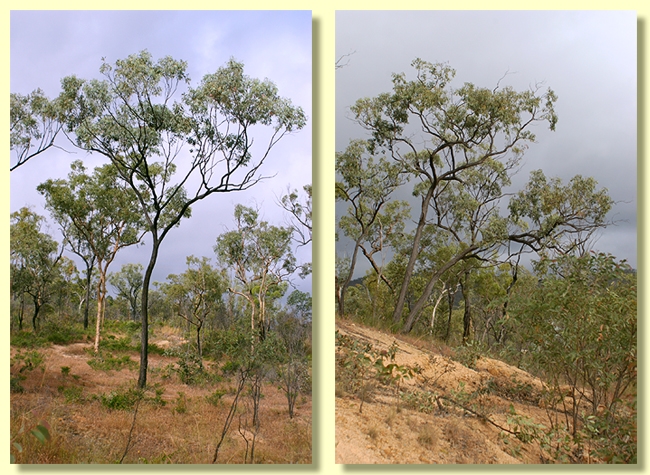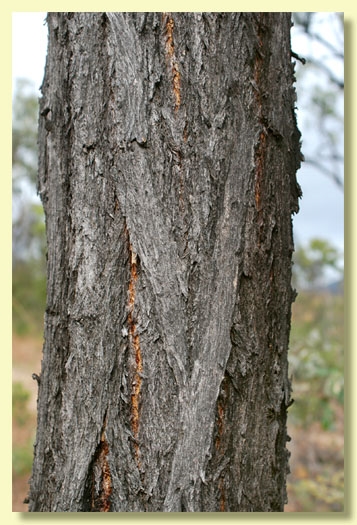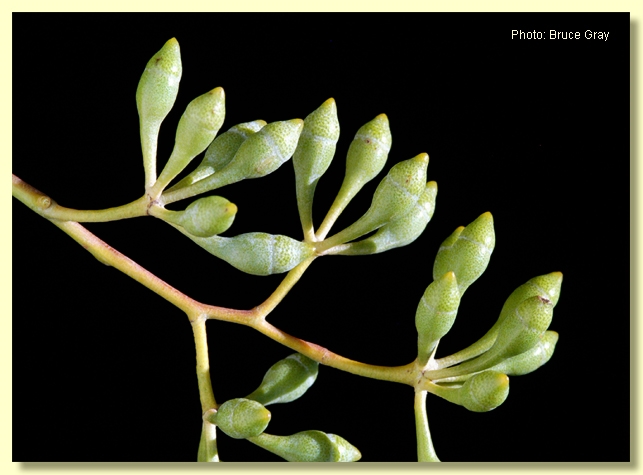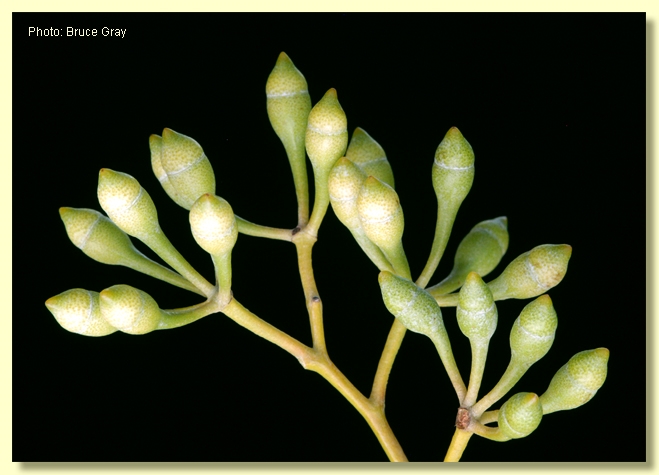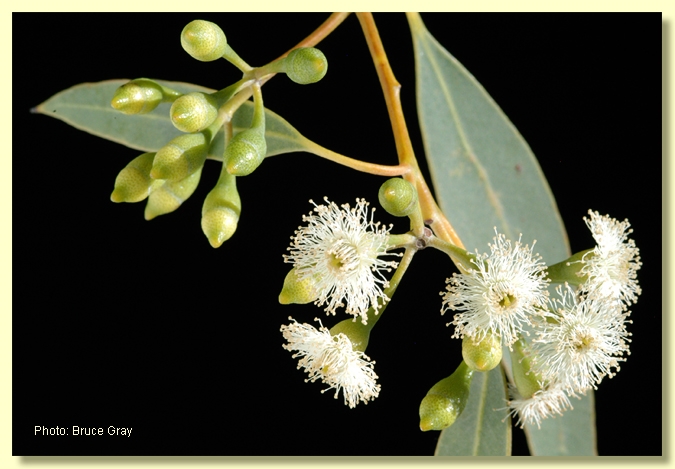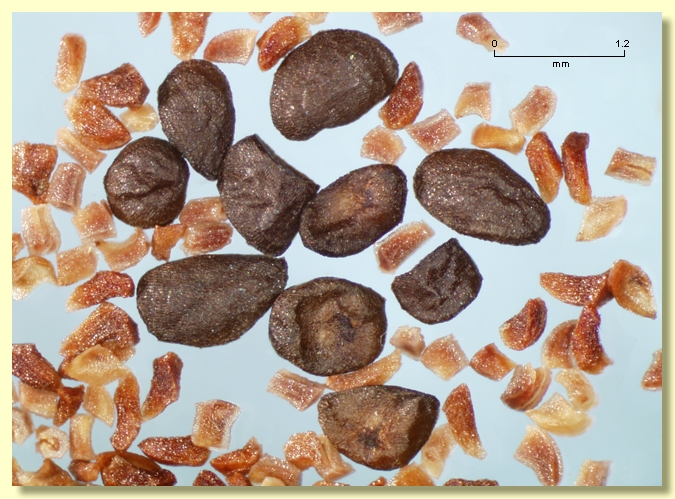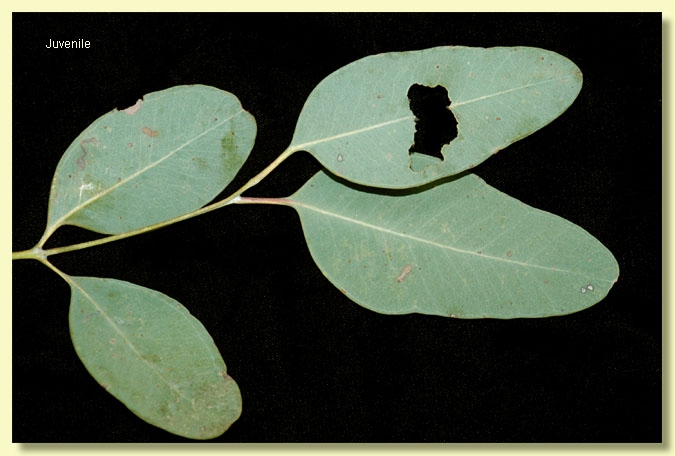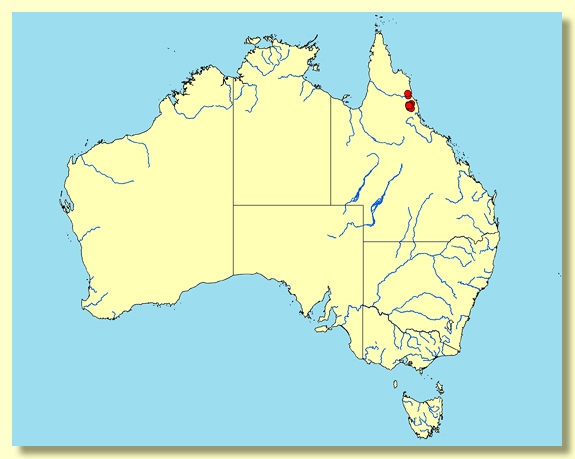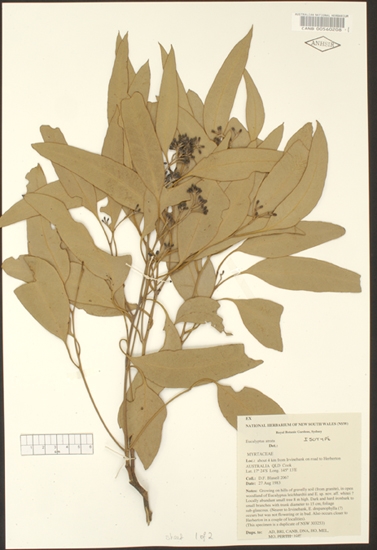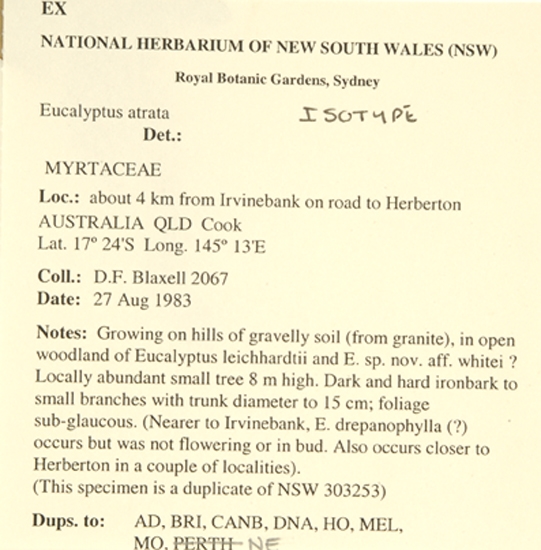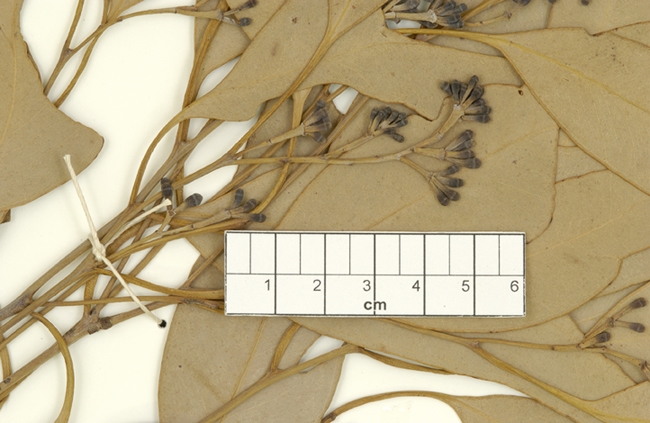Euclid - Online edition
Eucalyptus atrata
Eucalyptus | Symphyomyrtus | Adnataria | Apicales | Siderophloiae | Subglaucae
Usually a small tree to 10 m tall, occasionally taller to 15 m. Forming a lignotuber.
Ironbark to the small branches, dark grey to black; branchlets usually glaucous but this wax fades with age.
Juvenile growth (coppice or field seedlings to 50 cm): stem square to rounded in cross-section, glaucous; juvenile leaves petiolate, alternate, ovate to broadly lanceolate, 8–19 cm long, 3.5–8 cm wide, base tapering to petiole, glaucous.
Adult leaves alternate, petiole 1.7–3 (3.5) cm long; blade lanceolate, 8–15 (17.5) cm long, 1.4–3.4 cm wide, base tapering to petiole, concolorous, dull, blue-grey to glaucous, side-veins normally at an angle greater than 45° to midrib, densely reticulate, intramarginal vein parallel to and just within margin, oil glands intersectional.
Inflorescence terminal compound, peduncles 0.5–1.2 cm long, buds usually 7 per umbel, pedicels(0.2)0.4–0.6 cm long. Mature buds obovoid to ovoid, 0.6–0.8 cm long, 0.4–0.5 cm wide, glaucous, scar usually present (first operculum sheds very early in bud development), operculum conical to rounded to sometimes slightly beaked, stamens irregularly flexed, anthers cuboid, adnate, slits or pores separate, style long, stigma pin-head shaped, locules 4, the placentae each with 4 vertical ovule rows. Flowers white.
Fruit on pedicels 0.2–0.7 cm long, cup-shaped to hemispherical, 0.4–0.8 cm long, 0.5–0.8 cm wide, young fruit usually glaucous but this wax fades with age, disc level to descending, valves 4, tips near the rim or enclosed or sometimes slightly exserted.
Seeds brown, 1–1.8 mm long, flattened-ovoid, dorsal surface shallowly reticulate, hilum ventral.
Cultivated seedlings (measured at ca node 10): cotyledons oblong to reniform; stems square in cross-section; leaves always petiolate, opposite for 4–6 nodes then alternate, broadly lanceolate, 7.5–11 cm long, 3–7 cm wide, base tapering, margin entire, apex pointed, slightly discolorous, dull, grey-green.
Flowering has been recorded in January, February, September and December.
A small ironbark tree restricted to a few scattered locations near the Atherton Tableland in North Queensland, the most common sites being around the Herberton – Irvinebank – Stannary Hills – Mareeba area, with a population further north in the Mt Windsor Tableland area and also the Mt Spurgeon area and others further south in the Ravenshoe area and also south of Mt Garnet. E. atrata is characterised by its glaucous adult leaves, its glaucous buds and its broad glaucous juveniles.
Within its sub-group E. atrata is very close to E. paedoglauca and may be conspecific with it. Both species have dull blue-grey to glaucous adult leaves, broad glaucous juveniles and obovoid buds with a blunt rounded operculum, where the operculum is often narrower than the hypanthium before it is fully developed. E. paedoglauca tends to be slightly less glaucous that E. atrata with non-glaucous buds and sometimes dull green adult leaves. (E. atrata is always glaucous in the buds.) In its area of occurrence it may also be confused with E. crebra, another species where the buds can sometimes have the operculum narrower than the hypanthium before full development. E. crebra differs by having non-glaucous buds and narrower juvenile leaves.
Other members of the sub-group with relatively broad glaucous juvenile leaves that may be confused with E. atrata are E. fibrosa subsp. nubila, E. farinosa, E. quadricostata, E. shirleyi, E. melanophloia, E. whitei and E. staigeriana. E. fibrosa subsp. nubila is distinguished by having buds with a long acute operculum (blunt to rounded in E. atrata), E. farinosa has orbicular juvenile leaves (broadly lanceolate to ovate in E. atrata), E. quadricostata has buds and fruit that are square in cross-section (round in E. atrata), E. shirleyi and E. melanophloia have sessile, opposite juvenile leaves in the mature crown, E. whitei and E. staigeriana have slightly narrower juveniles and buds that frequently have an acute operculum (usually blunt and rounded in E. atrata). All other members of this sub-group either have juveniles that are much narrower than E. atrata or their juveniles are green and not glaucous.
No other ironbark should be confused with E. atrata.
MORE ABOUT IRONBARKS
Eucalyptus atrata: Latin atratus , clothed in black, referring to the dark bark.

